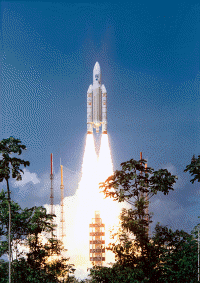Getting into space
 Getting into space
Getting into space
Ariana-5 uses both solid and liquid fuel to propel spacecraft into space (image: ESA/CNES/Arianespace-Service Optique CSG) | |
|
|
Getting into space is difficult. The Earth's pull of gravity is strong and a rocket must accelerate to 11 kilometres per second to escape. Traditionally, chemical rockets have been used to leave Earth's gravitational field because the sudden burning of the rocket fuel releases a tremendous amount of energy. The hot gases created during combustion are focused through nozzles at the base of the rocket and this drives it in the opposite direction, upwards.
Some rockets use solid fuel, others use liquid. Once solid fuel is lit, it burns completely and immediately. You can use liquid fuel, however, in a more controllable way since valves can increase or decrease the flow, so regulating the thrust. The escape velocity to leave Earth is about 25 times faster than sound and it is conceivable that, one day, 'spaceplanes' may be able to take off from runways, just as aircraft do at present. They would first accelerate to supersonic velocity, similarly to Concorde, and then continue accelerating until they reach hypersonic velocity and fly out of the Earth's atmosphere into space. Studies of such spaceplanes have shown that they will be highly challenging to build. For the foreseeable future, we will continue to use chemical rockets to enable spacecraft to leave Earth. Once in space, there are several ways of travelling and ESA is currently studying a number of alternatives.

